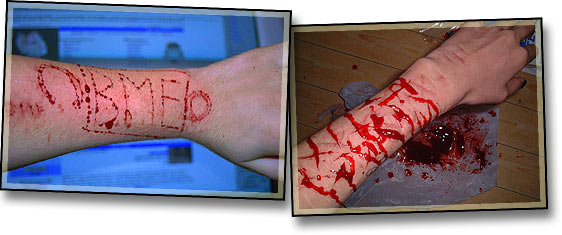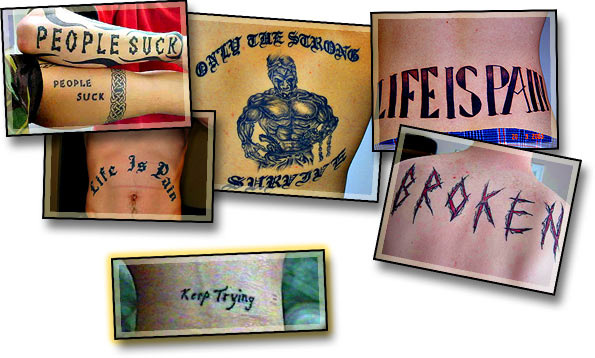
People in glass houses… by Shannon Larratt |
Nature shows that with the growth of intelligence comes increased capacity for pain, and it is only with the highest degree of intelligence that suffering reaches its supreme point.– Arthur Schopenhauer
|
The Art of Self Mutilation by Cora Birk
I’m a cutter. I’ve been doing it on and off since I was seven years old. When I first started, I did it with razor blades in the bathroom while no one was around and in places where no one would see… I enjoyed the pain and the blood, and the feel of metal opening up my skin. No one ever caught me, even with the worst of my scars from that time, which is now a hairline fade that goes from my right kneecap to my right ankle. After all these years it’s still my favorite mark.
|
Self Injury by Monty Vogel
I don’t think most SI’s believe that they’ve found the best method for coping with their problems; just something that works for now. Most of the people I spoke with would like to find a better way, but have problems reaching out for help and understanding. I believe the more we understand about self injury, the easier it will be for self injurers to find that needed help.
|
It’s not unusual for me to get photos and stories submitted to BME of subjects that most people will assume are “self-injury” or “cutting” in the clinical sense of the word. It will come as no surprise that these stories are almost universally rejected by the review team, and when I post the pictures they’re met with complaints ranging from “these people are sick” to “these people will make us look bad”… But I think if we’re to play that game fairly, we have to call a spade a spade — all of us body modifiers are demented sick-in-the-head self-mutilators that ought to get psychiatric help before we hurt ourselves.
But that can’t be true, can it?

Self-injurers tend to describe their acts as a stabilizing force in their lives. It grounds them, and keeps them sane. While it is true that for many there are less physically damaging drugs available which can help them cope, these often come with mental “zombie” side-effects that many find unacceptable. To put it simply, many self-injurers cut not simply to hurt themselves, but to heal themselves — on some levels, the cutting improves or even saves their lives.
Now let’s take a cold look at body piercing and tattooing. It is a painful act done without anesthesia or pain control, often in unregulated and unsanitary situations that put the wearer at needless risk, to say nothing of the long term potentially stigmatizing and life-destroying effects. If we are to judge ourselves by the same standards, that is… And what of suspension, pulling, and play piercing? Or even SM sex play where people “get off” on pain? Clearly on an objective level these are sick people hurting themselves for no good reason.
But we know that’s not true because we’ve been there. After all, we hold up as a hero the woman who reclaims her body with a genital piercing after being raped. We don’t even think to point out that maybe she’s now a headcase that’s carrying on the abuse by mutilating her genitals — because we know that’s not true. We’re thrilled to read the story of the young down-on-his-luck man who’s feeling “reborn” after his first suspension — we would never say “well, if you thought he was messed up before, look at the sick stuff he’s doing now, hanging from hooks!”
Maybe you’re telling yourself that you and the folks I’ve just mentioned in the previous paragraph are “better” than self-injurers because you’re wearing marks of “something good” (which you probably can’t put into words, let alone prove to a psychiatrist). Ignoring the fact that to some self-injurers the cuts represent survival (“something good”), and ignoring the fact that many “normal” people see all modifications as marks of “something bad”, plenty of modifications are very specific markers of problems — after all, “Born to Lose” and “Life is Pain” are two of the most persistent and popular classic tattoo designs.
…and you’re telling me that saying “I’m a survivor” is somehow worse than “I’m a loser”?

(Let me just be clear so there’s no hurt feelings: I don’t think there’s anything wrong with these tattoos either and I think they’re perfectly legitimate statements on the part of the wearers!)
It should come as no surprise that many people see pain as good and life-affirming. “No pain, no gain” is the motto of a vast number of self-improvement schemes — we understand that facing and surviving pain is a part of bettering oneself and of facing life’s challenges. Even “love hurts”. Extreme athletes and thrill seekers describe feeling more and more alive the closer they get to death. We make heros of people who’ve lived through painful accidents, and reward those who endure painful trials of fire. Pain may hurt, but all of our legends and myths tell us that it’s the path to divinity.
Now, don’t get me wrong. I’m not saying that we should encourage people to see injuring themselves as a solution. If someone is hacking up their arm to get through life, then there are very likely problems in their life that need fixing — but don’t ever assume that the injury is the problem. At best it’s a symptom, and no one was ever helped by trying to suppress their symptoms. And guess what — sometimes tattoos and piercings are also symptoms of a problem. So are lots of things.
If self-injury helps a person improve their lives, then it’s a good thing in my books, and every bit as valid as an injury that you happened to pay someone else to do to you. Personally, I even think it can look good. So try and treat them with the same respect and caring as you’d expect from some mundane about to approach you about your facial piercings.
Be healthy,

Shannon Larratt
BMEzine.com
 BME/News and Modblog highlight only a small fraction of what BME has to offer. Take our free tour and subscribe to BME for access to over 3 million body modification related photos, videos, and stories.
BME/News and Modblog highlight only a small fraction of what BME has to offer. Take our free tour and subscribe to BME for access to over 3 million body modification related photos, videos, and stories.